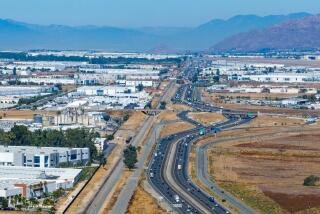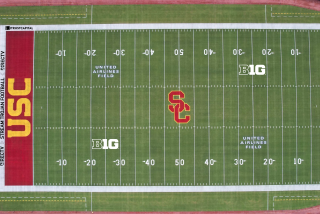CSUCI Seeks Land Swap for New Entry
- Share via
Calling it essential to the development of Cal State Channel Islands, university officials are close to making an unusual swap of farmland that would allow them to build a new main entrance into the campus and construct several sports fields.
The proposed two-lane entry off Lewis Road is needed to provide more direct access in and out of the isolated campus in the event of an emergency, campus officials said. It would become the public’s main entry to the university, surrounded by cropland on one side and sports fields on the other.
But Richard Francis, coauthor of a countywide growth-control measure, said that with more conscientious planning, the university could have avoided using farmland for its sports parks and road.
“This breaks the faith because the university projected it would reuse the facility that was already there,” he said. The university should construct the sports fields on land it has slated for a development of 900 homes, he said.
The university’s proposal involves swapping 75 acres of privately owned cropland between Lewis Road and the university for about the same amount of land from a 266-acre parcel in Camarillo owned by the university. The swap means a net loss of 75 acres of farmed land, a politically sensitive issue in a county with strict protections on agriculture.
Francis’ growth-control measure, Save Open Space and Agricultural Resources, requires that any conversion of farmland be put to a vote. But government agencies are exempt from such votes when developing their land.
“Because of where the university sits, I have a great deal of concern about its growth-inducement potential--so close to Camarillo--and in the middle of farmlands,” Francis said. “I think universities are socially beneficial, I just wish it wasn’t right where it is.”
Woody Hansen, one of the owners of the 75 acres next to Lewis Road, said he would like to keep the property, but he said he can’t argue with the state of California.
“I don’t want to stir up controversy, but I don’t have any options,” he said. “You can’t stop the university.”
He said negotiations for the land swap are in the beginning stages, but declined to say what he would farm on his new acreage in Camarillo if the land swap goes through.
The university’s 266-acre parcel of land near Central Avenue and Beardsley Road is currently used to grow lemons and row crops. It was Cal State’s choice for the campus before the former Camarillo State Hospital complex was selected.
University President Handel Evans said officials spent considerable effort trying to reduce the impact on surrounding farmland, and he feels 75 acres is a compromise compared to how many farm acres could have been used.
“The whole 260 acres were going to be taken out of [farm] production in order to build a university in the first place,” he said.
“That was the original site. As part of the transfer, we looked at how we could reduce the size to not eat up any more agriculture land than we need to. It’s not as if we are building on it. We are putting playing fields and all sorts of other things.”
About 40 acres would be used for fields, about 10 acres for a settling pond and 10 acres for a retention basin, said George Dutra, chief planner for the university.
The road, which would include a bike lane, would be built on the north side of the to-be-acquired property, leading drivers from the Ventura Freeway to the heart of the campus.
“Quite frankly, we couldn’t accommodate 11,750 students without this road,” Dutra said. “It’s essential to the development of the campus. We didn’t want to widen our current two-lane road because it would ruin the look of it.”
The current main entrance is along University Drive, off Lewis Road. Potrero Road runs along the back of the university and is another access point, but it is rarely used, Dutra said.
For the land swap to be executed, the Legislature must pass a bill authorizing the transaction. Dutra said if the bill is passed and signed by the governor in September, the university could proceed with the land swap in October. The new road, which at some point would be doubled from two to four lanes, would not be constructed for about three years, he said.
More to Read
Sign up for Essential California
The most important California stories and recommendations in your inbox every morning.
You may occasionally receive promotional content from the Los Angeles Times.













